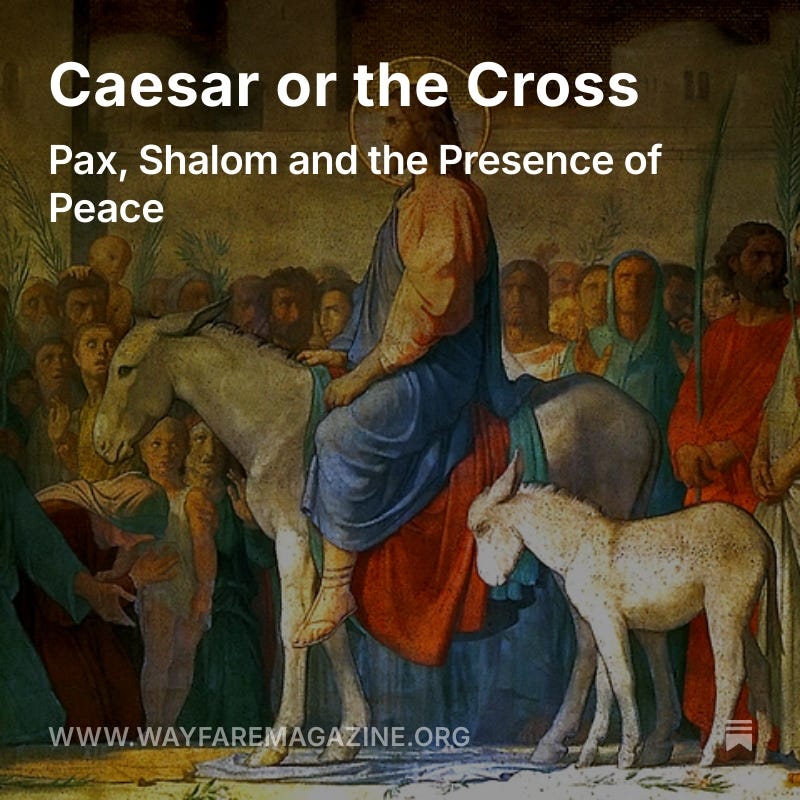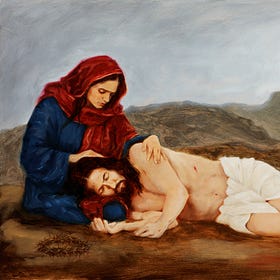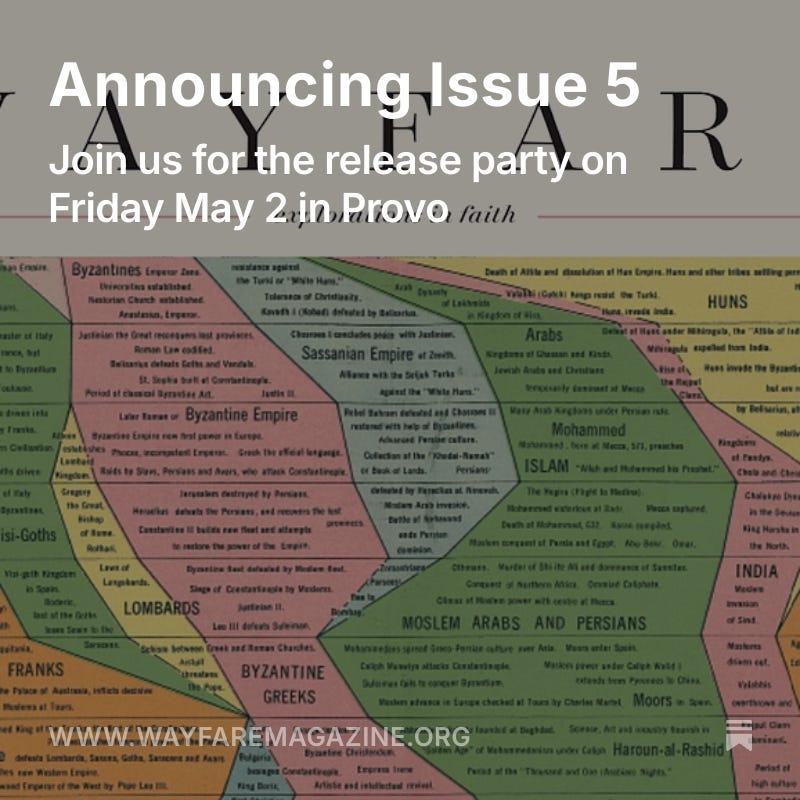Adam Miller & Rosalynde Welch: How to Have a Conversation with God
Plus: Resources for Holy Week
Today, we’re so excited to welcome Adam Miller and Rosalynde Welch to talk about their brand-new book, Seven Visions. This book is an exploration of seven visionary experiences in the Doctrine and Covenants—moments where heaven and earth meet in powerful and sometimes surprising ways. Through these visions, Adam and Rosalynde invite us to consider how we engage with scripture and revelation in our own lives.
In this conversation, we explore what it means to truly see God’s face and hear god's voice and that so often, revelation comes by paying attention to what is closest to us—the relationships and experiences that challenge us, stretch us, and ultimately transform us.
Adam and Rosalynde suggest that rather than treating scripture as something fixed and unchanging, we can approach it as an active, unfolding conversation. As Rosalynde put it, “The meaning of scripture is not fixed inside the covers of the book, but it unfolds in the space between the reader and the text.” We love their insights about passages of scripture that feel unsettling. Could our discomfort itself be a catalyst for revelation? And could the very questions we feel most compelled to ask be what expands our capacity to recognize Christ as He truly is—and to see the world more as He sees it?
This was such a rich and expansive conversation, and we hope it gives you a new lens for engaging with scripture and revelation.
For more on these topics, check out:
JOIN WAYFARE FOR HOLY WEEK
Find a short post from Wayfare with art, poetry, and scripture for each day of Holy Week here, and be sure you are subscribed to Wayfare and have turned on notifications for “Holy Days” to receive each post as a daily email to inspire you during Holy Week this year!
Study “Come Follow Me” with Faith Matters
Easter & Holy Week resources from Faith Matters
How to celebrate Holy Week, different ways to think about the Atonement, why we should consider the cross, what new life Easter can bring, and more.
To receive Come Follow Me resource roundups from Faith Matters in your inbox, first be sure you are subscribed to the Faith Matters Substack, then go to manage your subscription and turn on notifications for “Come Follow Me”.
VIEW “THE GREATEST ACT OF LOVE” AT THE COMPASS



In Latter-day Saint culture, we often focus on the Resurrection and triumph over death as the primary purpose of Christ's crucifixion. While this doctrine is important, could the emphasis solely on the triumph over death create a gap in our understanding of Christ's sacrifice? Consider this: what does the crucifixion of Jesus Christ reveal about God's character? What does Christ's physical suffering on the cross as the "The God of Friday" teach you about human suffering? And what can we learn about healing, mercy, empathy, and solidarity in pondering this sacred act?
Visit The Compass in downtown Provo now through May 31 to view “The Greatest Act of Love,” an art show centered on these important questions, or browse the art from the comfort of your home.
COMING UP AT THE COMPASS
Friends of Faith Matters and paid Substack subscribers get complimentary access to livestreams and recordings of The Big Questions series—a link will be emailed to you 24 hours before the event, and all recordings are saved here. Thank you for your support!
Our Compass events are subsidized and made possible by private rentals of the space for wedding receptions, business retreats, birthday parties, and more. If you or someone you know has an event coming up, consider supporting Faith Matters by recommending The Compass!
Stay up-to-date with future Faith Matters events at The Compass by subscribing to our special Compass Events newsletter.













Love as Radical Monotheism: Bridging the Relational Godhead and Catholic Trinitarian Doctrine through the Lens of Divine Wholeness
Abstract
This paper explores divine love as the unifying substance within the Godhead from a Latter-day Saint perspective while engaging respectfully with the Catholic doctrine of the consubstantial Trinity. Drawing upon biblical teachings, modern revelation, classical theology, Kabbalistic symbolism, and personal family experience, it proposes that love is not merely an attribute but the very essence that binds the Father, Son, and Holy Ghost in perfect unity of purpose and will. This conceptual bridge offers a framework for interfaith dialogue, enriching both traditions and fostering spiritual unity grounded in the transformative power of divine love that restores wholeness from brokenness.
---
## Introduction: Grounding Our Vision in the Words of Jesus—From Blindness to Divine Wholeness
When Jesus healed the man born blind, He declared, *“For judgment I have come into this world, that those who do not see may see, and those who see may become blind”* (John 9:39). These words reveal a profound spiritual truth: physical sight is not the ultimate measure of understanding, and true vision comes through Christ’s healing power.
Grounded in the words and ministry of Jesus, this paper reflects on the journey from brokenness to wholeness—a journey vividly symbolized in the Apostle Paul’s experience of blindness on the road to Damascus (Acts 9). Temporarily deprived of his physical sight, Paul was led to confront the limitations of human understanding and the fragmentation of his former worldview. This moment of vulnerability echoes the Kabbalistic concept of *Shevirat ha-Kelim*, the “shattering of the vessels,” which describes a cosmic fragmentation of divine light into broken shards, symbolizing the brokenness and imperfection of creation.
In his blindness, Paul’s former vision was shattered, but through this breaking, he was led to a new, fuller sight. After encountering the risen Christ, Paul’s spiritual eyes were a vision of wholeness and unity that transcended all previous understanding. This transformation is reflected in his profound teaching in **1 Corinthians 13**, where he reveals love as the supreme and eternal force that restores unity and perfection:
> *“Though I speak with the tongues of men and of angels, but do not have love, I have become sounding brass or a clanging cymbal... Love bears all things, believes all things, hopes all things, endures all things. Love never fails.”¹*
Here, Paul articulates love not merely as an attribute but as the very essence that heals fragmentation and binds all things together in perfect harmony. His experience of the perfect Christ revealed that love is the ultimate reality—the “whole” that makes all else complete. Where before he may have seen through a lens of division and law, after his encounter, Paul saw through the lens of perfect love—wholeness that heals and unites.
This paper explores how this vision of divine love as the unifying substance of the Godhead bridges Latter-day Saint and Catholic theology. It honors the distinct personages of Father, Son, and Holy Spirit while emphasizing the perfect love that binds them in eternal unity. By engaging with Kabbalistic symbolism and Pauline theology, it invites a deeper appreciation of how love restores wholeness from brokenness—both in the Godhead and in human experience.
---
## The Latter-day Saint Understanding of the Godhead
Latter-day Saint scripture and modern revelation teach that the Godhead consists of three distinct personages: God the Father, His Son Jesus Christ, and the Holy Ghost. These beings are perfectly united in purpose, doctrine, and love, though separate in person and body.²
Doctrine and Covenants 130:22 states:
> *“The Father has a body of flesh and bones as tangible as man’s; the Son also; but the Holy Ghost has not a body of flesh and bones, but is a personage of Spirit.”*³
President Gordon B. Hinckley described the Godhead as “three separate and distinct beings who are one in purpose and doctrine.”⁴ Elder Dieter F. Uchtdorf emphasized that “God’s love is the source of all love” and binds believers in unity.⁵ Elder Jeffrey R. Holland has taught that the love of God is “the greatest, most powerful, and most enduring force in the universe,” and that it “binds us together in perfect unity” when we choose to live by it.⁶
This understanding reflects a God who, despite distinct personages, is perfectly unified in love and purpose—restoring wholeness where there might otherwise be division.
---
## The Catholic Doctrine of the Consubstantial Trinity
The Catholic Church professes one God in three co-equal, co-eternal persons sharing one divine substance (*homoousios*), as defined in the Nicene Creed (325/381 AD).⁷ The Catechism states: “The Trinity is One... one God in three persons, the ‘consubstantial Trinity.’”⁸
St. Augustine’s *De Trinitate* articulates the Holy Spirit as the bond of love between Father and Son, intrinsic to divine nature.⁹ The Cappadocian Fathers further developed this relational understanding.¹⁰ Contemporary theologians like Jürgen Moltmann describe the Trinity as a community of love,¹¹ echoed by Pope Benedict XVI’s affirmation that “God is love.”¹²
This doctrine emphasizes that the unity of God is grounded in perfect love, a love that is both the source and the bond of divine persons, reflecting wholeness beyond human fragmentation.
---
## Love as the Binding Substance of the Godhead: A Conceptual Bridge
While LDS theology emphasizes distinct personages united in love and purpose, Catholic doctrine stresses consubstantial unity. This paper proposes that love itself is the uncreated substance—the “nuclear fusion”—that holds the Godhead together in perfect harmony.
This idea aligns with Paul’s teaching that love never fails and is the greatest gift. It also resonates with the scriptural witness that God is love (1 John 4:8) and that His nature is to love perfectly and eternally.
Moreover, understanding God primarily as love profoundly enlarges our conception of His nature. Divine love is infinite, boundless, and transcendent—qualities that make God infinitely larger than any finite doctrinal formulation. In this light, traditional theological constructs, including the classical triune model, can appear limited or “puny” by comparison, as they often emphasize structural definitions over the overwhelming reality of God’s infinite love.
At the same time, this infinite love makes God deeply intimate and personal. Love is inherently relational; it invites connection, communication, and mutuality. Because God is love, He is not a distant or impersonal force but a living, personal Being who desires relationship with His children. This intimacy is reflected in the distinct personages of the Father, Son, and Holy Ghost, who engage with humanity in loving fellowship. Thus, divine love simultaneously magnifies God’s grandeur and draws us close, making worship and discipleship a profoundly personal experience.
This radical monotheism, centered on love as the very essence of God, invites us to see beyond rigid categories and appreciate the vastness of God’s nature. Love is not merely an attribute among others; it is the dynamic, infinite reality that sustains and unites all things. It is the eternal “glue” that binds the Father, Son, and Holy Ghost in perfect unity of purpose and will—yet infinitely greater than any human attempt to define or contain it.
By focusing on love as the uncreated substance, we embrace a vision of God that is both relational and infinitely expansive, calling us to worship not a limited theological concept but the living, loving God whose greatness surpasses all understanding.
---
## Personal Reflection: Family as a Witness of Divine Love
My grandparents’ marriage of over 55 years, marked by silent but profound love, and my parents’ lifelong devotion have been living examples of the love Paul describes in 1 Corinthians 13. Their love, patient and kind, imperfect yet enduring, reflects the divine love that binds the Godhead and calls us to unity.
These personal experiences have deepened my conviction that divine love is the ultimate reality and foundation of existence. They inspire me to seek greater unity in my own family, church community, and relationship with God.
---
## Implications for Faith and Interfaith Dialogue
Recognizing God as love deepens spiritual life and fosters unity. For Latter-day Saints, it reinforces relational harmony and service; for Catholics, it models ecclesial communion and charity. This bridge encourages interfaith respect, emphasizing shared values and inspiring hope.
By articulating love as the unifying substance of the Godhead, this paper invites ongoing theological reflection and mutual respect between LDS and Catholic perspectives on God’s nature.
---
## Conclusion
Love, as the uncreated substance binding the Godhead, offers a profound way to bridge LDS and Catholic theology. This shared understanding honors divine mystery and invites dialogue that enriches faith and fosters unity among God’s children.
---
## Bibliography
Hinckley, Gordon B. *Teachings of Gordon B. Hinckley*. Salt Lake City: Deseret Book, 1997.
Holland, Jeffrey R. “The Grandeur of God.” General Conference, April 2003.
Moltmann, Jürgen. *The Trinity and the Kingdom*. Minneapolis: Fortress Press, 1981.
Pelikan, Jaroslav. *The Christian Tradition: A History of the